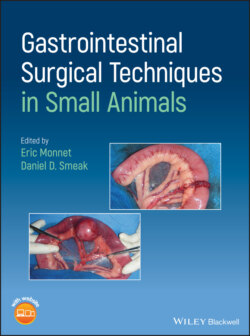Читать книгу Gastrointestinal Surgical Techniques in Small Animals - Группа авторов - Страница 91
5.1 Indications
ОглавлениеDrainage of the peritoneal space has been mostly performed for the treatment of peritonitis (Salisbury and Hosgood 1989; Hosgood 1990; Hosgood et al. 1991; Ludwig et al. 1997; Staatz et al. 2002; Buote and Havig 2012; Adams et al. 2014). Septic peritonitis and chemical peritonitis are the two most common conditions that are treated with some form of drainage. The main goal of the drainage is to decrease the bacterial load and/or to reduce the amount of chemical present in the pleural space.
Drainage is mostly indicated for generalized septic peritonitis. Drainage is also indicated if the cause of the peritonitis could not be totally controlled at the time of surgery (pancreatitis). Drainage is also indicated for a septic peritonitis associated with severe contamination with foreign materials (rupture of colon). The risk versus benefit of drainage has not been evaluated in a prospective trial to demonstrate the true benefit of drainage. “Drains provide a false sense of security and re‐assurance; we have all seen the moribund post‐operative patient with an abdomen crying to be reexplored while his surgeon strongly denies any possibility of intraperitoneal catastrophe because the tiny drains he inserted in each abdominal quadrant are ‘dry' and nonproductive. We cannot produce high‐level evidence to support our aversion to drains, but the generations of surgeons who used drains for many years also never succeeded in proving their advantage” (Schein 2002).
Open drainage has been historically used mostly during the treatment of generalized septic peritonitis with either presence of lot of foreign materials in the pleural space or bile. Bile salts are very caustic and potentiate the virulence of bacteria. Open drainage of the peritoneal cavity is rarely recommended in human medicine for the treatment of peritonitis (Schein 2002).
Drainage of the peritoneal space should also reduce the risk of compartment syndrome resulting from the accumulation of abdominal effusion in the close space of the abdominal cavity. It might be the major benefit of the drainage of the peritoneal space (Schein et al. 1995; Schein 2002).
Drainage of a uroabdomen due to a ruptured urethra or bladder is an important component of the stabilization for the patient before abdominal surgery. Drainage of the urine present in the abdominal cavity is an important component of the treatment of hyperkalemia present with a uroabdomen. After placement of a percutaneous drain diuresis can be started to help lower the potassium level.
